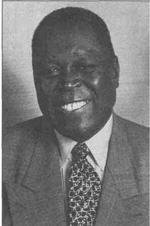 |
Home | Search | Browse | About IPO | Staff | Links |
Chicago

|
Stroger's win as loyal Democrat for By PAUL M. GREEN |
John Stroger's come-from-behind win in last month's Democratic primary for Cook County Board president was, in the end, an old-fashioned coalition victory. His surprise trouncing of Cook County Circuit Clerk Aurelia Pucinski and Cook County Commissioner Maria Pappas was based on county-wide geo-racial support.
How did it happen? What does it mean locally for the Democrats?
Back in November, right after Stroger, a longtime and loyal Democratic ward committeeman, was endorsed by the Cook County Democratic Central Committee, polls found him languishing in third place behind the better known Pucinski and the controversial Pappas. Going into late January, Stroger remained the campaign trailer as he labored to carve out a policy and political position. In the closing six weeks of the campaign, Stroger slowly climbed up the polls.
Policy-wise Stroger issued a thick statement entitled Leadership 2000: A Blueprint for Change in Cook County Government in which he detailed his views on crime, health care and the county budget situation. Not a great public speaker, Stroger looked unsure in most of his joint appearances. At a late January City Club of Chicago debate, however, Stroger began to hit his stride. He forcefully pushed his strong anti-crime views and chastised his two opponents for not having equally strong positions on this issue.
Politically, he had dual problems. First, he needed to unite the city's African-American community behind his candidacy without alienating crucial white ethnic and suburban support. Second, he had to answer black nationalist critics who attacked him for being too loyal to the Democratic party and Chicago Mayor Richard M. Daley.

John Stroger, Democratic candidate for Cook County Board president Photo by Willie Riley |
Ten days before the election, a Daily Herald-ABC television poll found Stroger surging past Pucinski and within a few points of Pappas. Unfortunately for Pappas her support was deemed the softest of the three candidates since she had the weakest field organization, meaning not enough election day vote-gathering forces. Also, a sizable chunk of Pappas' support came from individuals unsure of whether they would actually vote on primary day. Mayor Daley gave Stroger the critical final push in the campaign's closing days. Standing with Stroger in front of the criminal courts building, the mayor issued a "Daley double." First, he gave Stroger a strong endorsement for board president, which he quickly coupled with another vital political boost for his ally: a $100,000 campaign contribution. This was the final signal from the mayor to his close political associates and supporters. Two days before the election the power of the mayor's endorsement became apparent to all who attended the huge south side Irish St. Patrick's Day parade. In the heart of the heavily Irish Beverly neighborhood, Stroger was cheered as a "son of Erin." Perhaps the best indication of this bi-ethnic/racial |
46/April 1994/Illinois Issues
coalition were the countless campaign posters visible all along the parade route which read "Salute the Irish — Tom Hynes, Mike Sheahan [both of whom are popular Cook County officials from Bev-erly's 19th Ward] and John Stroger."
The breakdown of votes for the Democratic board president nomination shows the results of coalition politics. In Chicago Stroger defeated second-place finisher Pucinski by a 2-to-1 margin. As expected Stroger ran big in the predominantly African-American wards, especially in middle-class black south side precincts. Stroger also did well along the lakefront, winning pluralities in wards 42, 43, 46, 47, 48 and 49. The big electoral surprise, however, were his numbers in Daley's former Bridgeport home ward, the 11th, and in Hynes' 19th Ward (Beverly). Stroger garnered 60 percent of the vote in these two legendary ethnic southwest side wards.
In the county outside Chicago, the Democratic vote was nearly evenly split among the three candidates for board president. Stroger did best in those townships with sizable black populations, but he was competitive almost everywhere in suburban Cook County. Admittedly helping Stroger was Pappas' cut into Pucinski's base strength in northwest and southwest suburban areas, but even there Stroger racked up some significant township vote totals. For example, Worth Township gave him 27 percent of the vote, and Maine 23 percent.
In the November general election, Stroger will face Republican Joe Morris, an outspoken conservative. Stroger's strategy against Morris will be a simple twofold plan. First, Stroger will run as a Democrat (the last Republican to win the Cook County Board presidency was Richard B. Ogilvie in 1966), and second, he will solidify his multiracial coalition.
The Stroger victory is also a step in the march toward the Chicago Democratic mayoral primary next February. His nomination clearly enhances the renomination possibilities of Mayor Daley. All speculative Machiavellian analysis aside, Daley's loyalty to Stroger in essence merely demonstrates one of his father's oldest political maxims, "You win elections by addition."
Paul M. Green is director of the Institute for Public Policy and Administration, Governors State University, University Park.
April 1994/Illinois Issues/47
|
Sam S. Manivong, Illinois Periodicals Online Coordinator |